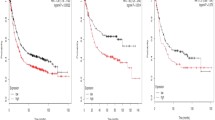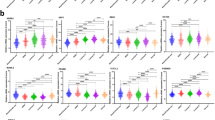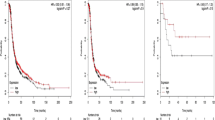Abstract
Notch receptors are frequently deregulated in several human malignancies including human breast cancer. Activation of Notch has been reported to cause mammary carcinomas in mice. However, the prognostic value of individual Notch receptors in breast cancer (BC) patients remains elusive. In the current study, we investigated the prognostic value of Notch receptors in human BC patients. More specifically, we investigated the prognostic value of four Notch receptors in breast cancer patients through “the Kaplan-Meier plotter” (KM plotter) database, in which updated gene expression data and survival information are from a total of 3554 breast cancer patients. Our results showed that Notch1 messenger RNA (mRNA) high expression was correlated to worsen overall survival (OS) in PgR-negative BC patients. Notch2, Notch3, and Notch4 mRNA high expressions were found to be correlated to better OS for all breast cancer patients. Notch2 was also found to be correlated to better OS in lymph node-negative breast cancer patients and HER2-positive breast cancer patients. These results will be useful for better understanding of the heterogeneity and complexity in the molecular biology of breast cancer and for developing tools to more accurately predict their prognosis and design their customized treatment strategies.




Similar content being viewed by others
References
Siegel R, Naishadham D, Jemal A. Cancer statistics, 2013. CA Cancer J Clin. 2013;63:11–30.
Redig AJ, McAllister SS. Breast cancer as a systemic disease: a view of metastasis. J Intern Med. 2013;274:113–26.
Coleman RE, Gregory W, Marshall H, Wilson C, Holen I. The metastatic microenvironment of breast cancer: clinical implications. Breast. 2013;22 Suppl 2:S50–6.
Korkaya H, Wicha MS. HER-2, notch, and breast cancer stem cells: targeting an axis of evil. Clin Cancer Res. 2009;15:1845–7.
Wang Z, Li Y, Ahmad A, Azmi AS, Banerjee S, et al. Targeting Notch signaling pathway to overcome drug resistance for cancer therapy. Biochim Biophys Acta. 2010;1806(2):258–67.
Lewis J. Notch signalling and the control of cell fate choices in vertebrates. Semin Cell Dev Biol. 1998;9:583–9.
Simpson P. Developmental genetics. The Notch connection. Nature. 1995;375:736–7.
Borggrefe T, Oswald F. The Notch signaling pathway: transcriptional regulation at Notch target genes. Cell Mol Life Sci. 2009;66:1631–46.
Kopan R, Ilagan MX. The canonical Notch signaling pathway: unfolding the activation mechanism. Cell. 2009;137:216–33.
Miele L. Notch signaling. Clin Cancer Res. 2006;12:1074–9.
Miele L, Miao H, Nickoloff BJ. NOTCH signaling as a novel cancer therapeutic target. Curr Cancer Drug Targets. 2006;6:313–23.
Callahan R, Raafat A. Notch signaling in mammary gland tumorigenesis. J Mammary Gland Biol Neoplasia. 2001;6:23–36.
Dievart A, Beaulieu N, Jolicoeur P. Involvement of Notch1 in the development of mouse mammary tumors. Oncogene. 1999;18:5973–81.
Kiaris H, Politi K, Grimm LM, Szabolcs M, Fisher P, et al. Modulation of notch signaling elicits signature tumors and inhibits hras1-induced oncogenesis in the mouse mammary epithelium. Am J Pathol. 2004;165:695–705.
Pece S, Serresi M, Santolini E, Capra M, Hulleman E, et al. Loss of negative regulation by Numb over Notch is relevant to human breast carcinogenesis. J Cell Biol. 2004;167:215–21.
Gyorffy B, Lanczky A, Eklund AC, Denkert C, Budczies J, et al. An online survival analysis tool to rapidly assess the effect of 22,277 genes on breast cancer prognosis using microarray data of 1,809 patients. Breast Cancer Res Treat. 2010;123:725–31.
Gyorffy B, Surowiak P, Budczies J, Lanczky A. Online survival analysis software to assess the prognostic value of biomarkers using transcriptomic data in non-small-cell lung cancer. PLos One. 2013;8:e82241.
Gyorffy B, Lanczky A, Szallasi Z. Implementing an online tool for genome-wide validation of survival-associated biomarkers in ovarian-cancer using microarray data from 1287 patients. Endocr Relat Cancer. 2012;19:197–208.
Gyorffy B, Benke Z, Lanczky A, Balazs B, Szallasi Z, et al. RecurrenceOnline: an online analysis tool to determine breast cancer recurrence and hormone receptor status using microarray data. Breast Cancer Res Treat. 2012;132:1025–34.
Liu M, Wang G, Gomez-Fernandez CR, Guo S. GREB1 functions as a growth promoter and is modulated by IL6/STAT3 in breast cancer. PLos One. 2012;7:e46410.
Tilghman SL, Townley I, Zhong Q, Carriere PP, Zou J, et al. Proteomic signatures of acquired letrozole resistance in breast cancer: suppressed estrogen signaling and increased cell motility and invasiveness. Mol Cell Proteomics. 2013;12:2440–55.
Zhou C, Zhong Q, Rhodes LV, Townley I, Bratton MR, et al. Proteomic analysis of acquired tamoxifen resistance in MCF-7 cells reveals expression signatures associated with enhanced migration. Breast Cancer Res. 2012;14:R45.
Maciejczyk A, Szelachowska J, Czapiga B, Matkowski R, Halon A, et al. Elevated BUBR1 expression is associated with poor survival in early breast cancer patients: 15-year follow-up analysis. J Histochem Cytochem. 2013;61:330–9.
Maciejczyk A, Lacko A, Ekiert M, Jagoda E, Wysocka T, et al. Elevated nuclear S100P expression is associated with poor survival in early breast cancer patients. Histol Histopathol. 2013;28:513–24.
Maciejczyk A, Jagoda E, Wysocka T, Matkowski R, Gyorffy B, et al. ABCC2 (MRP2, cMOAT) localized in the nuclear envelope of breast carcinoma cells correlates with poor clinical outcome. Pathol Oncol Res. 2012;18:331–42.
Adam MA. New prognostic factors in breast cancer. Adv Clin Exp Med. 2013;22:5–15.
Stylianou S, Clarke RB, Brennan K. Aberrant activation of notch signaling in human breast cancer. Cancer Res. 2006;66:1517–25.
Girard L, Hanna Z, Beaulieu N, Hoemann CD, Simard C, et al. Frequent provirus insertional mutagenesis of Notch1 in thymomas of MMTVD/myc transgenic mice suggests a collaboration of c-myc and Notch1 for oncogenesis. Genes Dev. 1996;10:1930–44.
Ling H, Sylvestre JR, Jolicoeur P. Notch1-induced mammary tumor development is cyclin D1-dependent and correlates with expansion of pre-malignant multipotent duct-limited progenitors. Oncogene. 2010;29(32):4543–54.
Parr C, Watkins G, Jiang WG. The possible correlation of Notch-1 and Notch-2 with clinical outcome and tumour clinicopathological parameters in human breast cancer. Int J Mol Med. 2004;14:779–86.
Raouf A, Zhao Y, To K, Stingl J, Delaney A, et al. Transcriptome analysis of the normal human mammary cell commitment and differentiation process. Cell Stem Cell. 2008;3:109–18.
Hua BL, Fu XG, Hu WH, Yin L, Kang XL, et al. Notch1 mRNA and protein expression in human breast cancer and normal mammary gland tissues. Zhonghua Bing Li Xue Za Zhi. 2009;38:806–9.
Guo S, Liu M, Gonzalez-Perez RR. Role of Notch and its oncogenic signaling crosstalk in breast cancer. Biochim Biophys Acta. 2011;1815:197–213.
O’Neill CF, Urs S, Cinelli C, Lincoln A, Nadeau RJ, et al. Notch2 signaling induces apoptosis and inhibits human MDA-MB-231 xenograft growth. Am J Pathol. 2007;171:1023–36.
Hu C, Dievart A, Lupien M, Calvo E, Tremblay G, et al. Overexpression of activated murine Notch1 and Notch3 in transgenic mice blocks mammary gland development and induces mammary tumors. Am J Pathol. 2006;168:973–90.
Yamaguchi N, Oyama T, Ito E, Satoh H, Azuma S, et al. NOTCH3 signaling pathway plays crucial roles in the proliferation of ErbB2-negative human breast cancer cells. Cancer Res. 2008;68:1881–8.
Zhang Z, Wang H, Ikeda S, Fahey F, Bielenberg D, et al. Notch3 in human breast cancer cell lines regulates osteoblast-cancer cell interactions and osteolytic bone metastasis. Am J Pathol. 2010;177(3):1459–69.
Gallahan D, Jhappan C, Robinson G, Hennighausen L, Sharp R, et al. Expression of a truncated Int3 gene in developing secretory mammary epithelium specifically retards lobular differentiation resulting in tumorigenesis. Cancer Res. 1996;56:1775–85.
Jhappan C, Gallahan D, Stahle C, Chu E, Smith GH, et al. Expression of an activated Notch-related int-3 transgene interferes with cell differentiation and induces neoplastic transformation in mammary and salivary glands. Genes Dev. 1992;6:345–55.
Imatani A, Callahan R. Identification of a novel NOTCH-4/INT-3 RNA species encoding an activated gene product in certain human tumor cell lines. Oncogene. 2000;19:223–31.
Soriano JV, Uyttendaele H, Kitajewski J, Montesano R. Expression of an activated Notch4(int-3) oncoprotein disrupts morphogenesis and induces an invasive phenotype in mammary epithelial cells in vitro. Int J Cancer. 2000;86:652–9.
Soares R, Balogh G, Guo S, Gartner F, Russo J, et al. Evidence for the notch signaling pathway on the role of estrogen in angiogenesis. Mol Endocrinol. 2004;18:2333–43.
Calaf GM, Roy D. Cell adhesion proteins altered by 17beta estradiol and parathion in breast epithelial cells. Oncol Rep. 2008;19:165–9.
Clarke CA, Glaser SL, Uratsu CS, Selby JV, Kushi LH, et al. Recent declines in hormone therapy utilization and breast cancer incidence: clinical and population-based evidence. J Clin Oncol. 2006;24:e49–50.
Lee S, Kolonel L, Wilkens L, Wan P, Henderson B, et al. Postmenopausal hormone therapy and breast cancer risk: the Multiethnic Cohort. Int J Cancer. 2006;118:1285–91.
Obr AE, Edwards DP. The biology of progesterone receptor in the normal mammary gland and in breast cancer. Mol Cell Endocrinol. 2012;357:4–17.
Hilton HN, Clarke CL. Impact of progesterone on stem/progenitor cells in the human breast. J Mammary Gland Biol Neoplasia. 2015;8:8.
Vares G, Sai S, Wang B, Fujimori A, Nenoi M, et al. Progesterone generates cancer stem cells through membrane progesterone receptor-triggered signaling in basal-like human mammary cells. Cancer Lett. 2015;362:167–73.
Tai W, Mahato R, Cheng K. The role of HER2 in cancer therapy and targeted drug delivery. J Control Release. 2010;146(3):264–75.
Tzahar E, Yarden Y. The ErbB-2/HER2 oncogenic receptor of adenocarcinomas: from orphanhood to multiple stromal ligands. Biochim Biophys Acta. 1998;1377:M25–37.
Slamon DJ, Godolphin W, Jones LA, Holt JA, Wong SG, et al. Studies of the HER-2/neu proto-oncogene in human breast and ovarian cancer. Science. 1989;244:707–12.
Chen Y, Fischer WH, Gill GN. Regulation of the ERBB-2 promoter by RBPJkappa and NOTCH. J Biol Chem. 1997;272:14110–4.
Magnifico A, Albano L, Campaner S, Delia D, Castiglioni F, et al. Tumor-initiating cells of HER2-positive carcinoma cell lines express the highest oncoprotein levels and are sensitive to trastuzumab. Clin Cancer Res. 2009;15:2010–21.
Acknowledgments
This work is supported by the scientific research project of Shanghai Science and Technology Committee (14411950205, 15411967200).
Conflicts of interest
None
Author information
Authors and Affiliations
Corresponding author
Rights and permissions
About this article
Cite this article
Xu, J., Song, F., Jin, T. et al. Prognostic values of Notch receptors in breast cancer. Tumor Biol. 37, 1871–1877 (2016). https://doi.org/10.1007/s13277-015-3961-6
Received:
Accepted:
Published:
Issue Date:
DOI: https://doi.org/10.1007/s13277-015-3961-6




